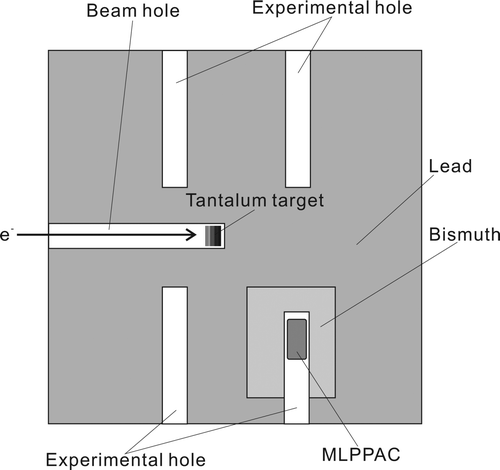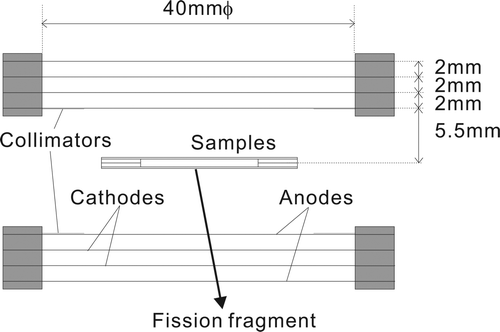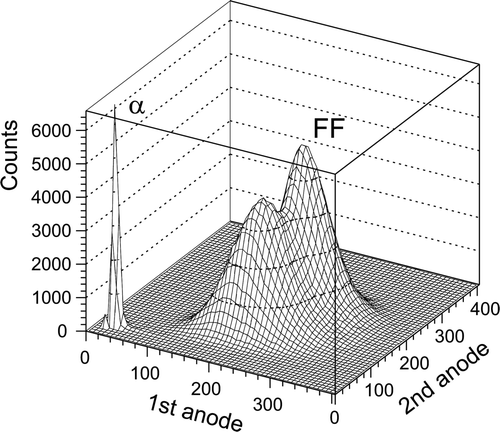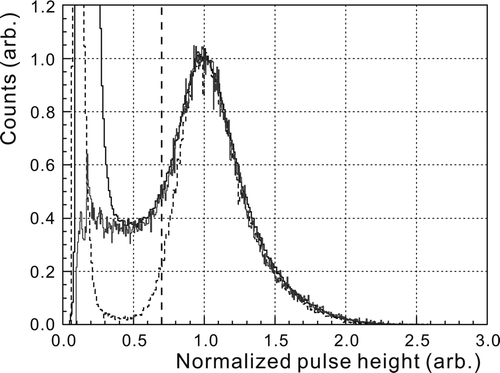Figures & data
Figure 1. Top view of KULS. Photo-neutrons produced in the tantalum target are slowed down in the lead material. Fission fragments are detected with MLPPAC (multi-layered parallel-plate avalanche chamber) placed in one of the experimental holes provided to KULS.

Table 1. The number of atoms in each sample.
Figure 2. MLPPAC has two sets multi-layered electrode. Each consists of four foils of aluminized polyester. Two samples are located between them.

Figure 3. The correlation between the pulse heights of the first and the second anode signals observed in the measurement of 245Cm. The fission fragments are clearly separated from
particles.

Figure 4. The thick and the thin solid lines show the pulse-height spectra for the reference sample of 235U(A) used in the measurements of Am and 245Cm
, respectively. The dashed line shows that of 235U(B).

Figure 5. The open circles show the cross section for 237Np before subtracting the background from 239Pu
. The result of the background subtraction performed using the JENDL-4.0 evaluation is shown by the closed circles.

Figure 6. The cross section for 237Np obtained in this work (closed circles) is compared with the other experimental data, Yamanaka et al. [Citation1], Carlson et al. [Citation3], Gerasimov et al. [Citation2] and Tovesson and Hill [Citation4].
![Figure 6. The cross section for 237Np obtained in this work (closed circles) is compared with the other experimental data, Yamanaka et al. [Citation1], Carlson et al. [Citation3], Gerasimov et al. [Citation2] and Tovesson and Hill [Citation4].](/cms/asset/80f6728e-aef5-48d6-b015-0dfb6ebe8989/tnst_a_730895_o_f0006g.jpg)
Figure 7. The resulting cross section for Am
shown by the closed circles is compared with other experimental data, Gerasimov et al. [Citation2], Kai et al. [Citation8] and Alekseev et al. [Citation9].
![Figure 7. The resulting cross section for Am shown by the closed circles is compared with other experimental data, Gerasimov et al. [Citation2], Kai et al. [Citation8] and Alekseev et al. [Citation9].](/cms/asset/1e592cfa-6dd7-416f-8809-5449f037107f/tnst_a_730895_o_f0007g.jpg)
Figure 8. The resulting cross section for 245Cm shown by the closed circles is compared with Block et al. [Citation12], Gerasimov et al. [Citation2], and Alekseev et al. [Citation9].
![Figure 8. The resulting cross section for 245Cm shown by the closed circles is compared with Block et al. [Citation12], Gerasimov et al. [Citation2], and Alekseev et al. [Citation9].](/cms/asset/42828122-8871-49d2-9679-9595333d27e0/tnst_a_730895_o_f0008g.jpg)